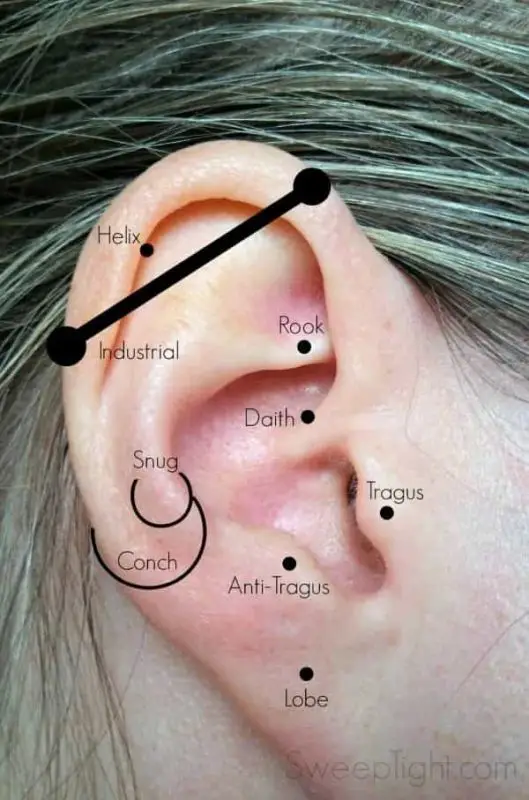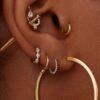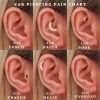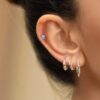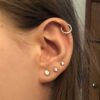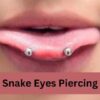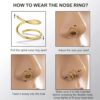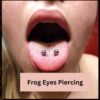Ear Piercing
Rook Piercing vs Daith – Which One’s for You? A Complete Comparison Guide
Choosing between the Rook and Daith piercings can be daunting, given each has its unique appeal.
In a hurry? Here’s a quick answer to “Rook Piercing vs Daith”: Rook piercings are located on the antihelix of the ear, above the tragus, and are generally adorned with curved barbells or captive bead rings. Daith piercings, on the other hand, are situated in the innermost cartilage fold of the ear and usually feature hoops or captive bead rings as jewelry..
Picking a piercing is more than just about looks. It’s about pain considerations, aftercare, and the style statement you’re making. Our guide delves deep into these piercings, highlighting pain thresholds, healing steps, fashion implications, and expert insights.
Here’s what’s ahead:
- Detailed exploration of Rook and Daith Piercings.
- Pain comparisons and expectations.
- Healing journeys and aftercare advice.
- Fashion trends and their current status.
- Cost insights and comparisons.
- Expert perspectives and guidance.
- A comprehensive FAQ for all your queries.
Dive in and make an informed choice!
Contents
- 1 What is Rook Piercing?
- 2 What is a Daith Piercing?
- 3 The Aesthetic Appeal: Rook vs Daith
- 4 Pain Level: Which One Hurts More?
- 5 Rook and Daith Piercings: Pros and Cons
- 6 Rook Piercing vs Daith: Healing Time and Aftercare
- 7 Rook vs. Daith Piercings: A Detailed Comparison Table
- 8 Potential Complications and How to Avoid Them
- 9 Rook Piercing vs Daith Cost:
- 10 Rook Piercing vs Daith Which is for you? – Questions to Ask Yourself
- 11 Rook Piercing vs Daith: Quick Summary
- 12 FAQs
- 13 Final Words: Rook Piercing vs Daith
What is Rook Piercing?
A rook piercing is a type of ear piercing where a hole is made in the antihelix of the ear to insert jewelry. The antihelix is the inner ridge of the ear, just above the tragus. Depending on the jewelry you choose, a rook piercing can be a subtle or bold fashion statement.
- Related: Orbital vs Conch Piercing

Journey Through Time
Interestingly, while many of today’s piercings have ancient roots, the rook is a relatively modern addition to the family. It was first popularized in the 1990s. Still, it’s believed that various ear piercings have tribal origins, each carrying a story or significance. Today, the rook is cherished for its unique placement and the myriad of jewelry options available.
What is a Daith Piercing?
A daith piercing is a type of ear piercing where a hole is made in the innermost cartilage fold of the ear to insert jewelry. This piercing is usually performed with a straight hollow needle and captive bead rings are the most common jewelry type used.
Migraine Relief: Myth or Reality?
One intriguing angle that often comes up with the daith is its rumored connection to migraine relief. The theory? Piercing the daith impacts a particular pressure point, alleviating migraine symptoms. While some wearers swear by its therapeutic benefits, it’s worth noting that scientific evidence on this claim is still inconclusive. However, whether for style or solace, the daith has found its way into the hearts (and ears) of many.
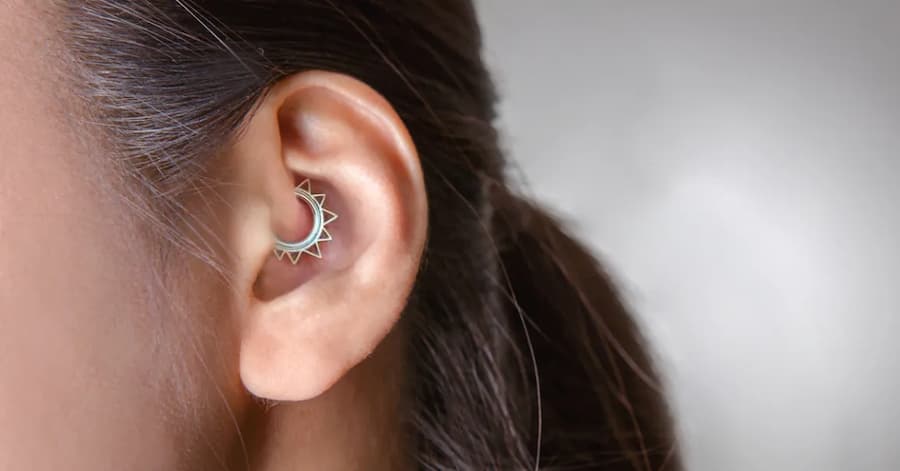
The Aesthetic Appeal: Rook vs Daith
Rook Piercing vs Daith: A Duel of Beauty
When we talk aesthetics, both rook and daith piercings have their unique charm. The rook, with its high and inward location, offers a somewhat hidden mystery, especially when viewed from the front. The daith, on the other hand, nestles itself cozily in the inner ear curve, giving off a gentle yet pronounced appeal. Which will captivate your audience more? Only you can decide.

Jewelry Choices: The Icing on the Cake
Your choice of jewelry can make or break the look. For rook piercings, curved barbells and captive bead rings tend to be popular picks. They fit snugly and accentuate the piercing’s distinct location.
Daith enthusiasts often gravitate towards heart or crescent-shaped hoops, adding a touch of whimsy to the inner ear. But remember, the world of jewelry is vast. Let your personal style guide your choice!
Pain Level: Which One Hurts More?
Rook vs Daith: The Pain Game
Let’s be honest: pain is relative. What might be a mere pinch for some could be a sharp sting for others. However, general feedback suggests that the daith might have a slight edge in the discomfort department, given its thicker cartilage. The rook, while not pain-free, often scores a tad lower on the pain scale.
- Related: Pain Ear Piercing Chart
Rook and Daith Piercings: Pros and Cons
When it comes to accentuating your ears with piercings, both Rook and Daith offer unique style statements. However, like any choice, they come with their set of benefits and considerations.
Let’s weigh their pros and cons to aid your decision-making.
Rook Piercing:
Pros:
- Fashion Forward: Offers a unique and trendy look that stands out from common ear piercings.
- Variety in Jewelry: Can be adorned with a range of jewelry types, from barbells to curved rings.
- Less Common: Not as prevalent as some other piercings, making it a more distinctive choice.
Cons:
- Pain Levels: Among the more painful ear piercings due to its location through thick cartilage.
- Longer Healing Time: May take several months to a year to completely heal.
- Risk of Bumps: Can develop keloids or hypertrophic scars if not cared for properly.
Daith Piercing:
Pros:
- Potential Migraine Relief: Some anecdotal evidence suggests it might help in reducing migraine pain, although it’s not scientifically confirmed.
- Distinctive: Located in the innermost cartilage of the ear, it provides a unique look.
- Versatile Jewelry Choices: These can be adorned with hoops, heart rings, or studs, allowing for creative expression.
Cons:
- Moderate Pain: Piercing through the ear’s thick inner cartilage can be painful.
- Healing Time: Like the Rook, the Daith can also take several months to a year to heal fully.
- Difficult Aftercare: Its location can make it tricky to clean and care for, increasing the risk of infections.
Rook Piercing vs Daith: Healing Time and Aftercare
The Wait is Worth It
While we all wish for instant healing, patience is key. A rook piercing typically takes anywhere from 6 to 12 months to fully heal, while a daith might require a similar timeline, sometimes extending up to a year.
Rook vs. Daith Piercings: A Detailed Comparison Table
| Feature/Aspect | Rook Piercing | Daith Piercing |
|---|---|---|
| Aesthetic Appeal | Located high and inward, offering a hidden mystery. | Nestled in the inner ear curve, discreet yet distinctive. |
| Popular Jewelry | Curved barbells, captive bead rings. | Heart or crescent-shaped hoops, captive bead rings. |
| Pain Level | Generally scores lower on the pain scale. | Might have a slight edge in discomfort due to thicker cartilage. |
| Healing Time | 6 to 12 months. | Similar timeline, up to a year. |
| Aftercare | Saline solution rinse twice daily. Avoid touching with dirty hands. | A similar cost range, $40 to $100, varies by region and studio. |
| Potential Complications | Swelling, redness, or infections if not cared for. | Same as a rook. Saline rinse and avoid unnecessary friction. |
| Cost Range | Generally $40 to $100, influenced by various factors. | Generally, $40 to $100, influenced by various factors. |
| Unique Features | Relatively modern addition, popularized in the 1990s. | Rumored connection to migraine relief, though scientifically inconclusive. |
Potential Complications and How to Avoid Them
Heed the Warning Signs
While complications are rare, they’re worth being aware of. Both piercings might experience swelling, redness, or even infections if not cared for properly.
Proactive Steps to Serenity
To avoid complications, always get pierced by a professional in a reputable studio. Steer clear of “piercing guns” – they can cause trauma. At the first sign of persistent redness, unusual discharge, or prolonged pain, consult your piercer or a medical professional. Regular saline rinses and avoiding unnecessary friction can also keep complications at bay.
Rook Piercing vs Daith Cost:
The Price Tag: Rook vs Daith
When shelling out some cash, both the rook and daith piercings usually hover within a similar range. Depending on the region and the prestige of the piercing studio, you might be looking at anywhere from $40 to $100. However, the price doesn’t stop at the piercing itself.
Behind the Price: More Than Just the Piercing
Various factors can influence the overall cost. Your piercer’s expertise, the studio’s location, and the type of jewelry you choose can all sway the final amount. Moreover, investing in quality aftercare products and perhaps the occasional check-in with your piercer might add to your budget. Always remember: quality over quantity. A well-done piercing is priceless.
Rook Piercing vs Daith Which is for you? – Questions to Ask Yourself
Your Lifestyle, Your Piercing
Before making the plunge, consider your daily life. Are you active in sports or perhaps wear headphones often? Your lifestyle can determine which piercing might be more suitable or more of a hassle.
Personal Touch: Reflecting Inward
I’ve always believed that piercings, like tattoos, are deeply personal. Reflect on what draws you to each piercing. Is it the aesthetics? The potential health benefits? Your pain threshold? Your decision should resonate with who you are and how you want to express yourself.
Rook Piercing vs Daith: Quick Summary
When it comes to ear piercings, both Rook and Daith offer unique aesthetics and experiences. Here’s a quick comparison:
Rook Piercing:
- Location: On the antihelix of the ear, above the tragus.
- Pain Level: Moderate to high.
- Jewelry: Curved barbells or captive bead rings.
- Healing Time: 6-9 months.
Daith Piercing:
- Location: Innermost cartilage fold of the ear.
- Pain Level: Moderate.
- Jewelry: Hoops or captive bead rings.
- Healing Time: 6-10 months.
Key Differences:
- Aesthetics: Rook is more visible and offers a unique placement on the ear, while Daith is subtler and offers a more inward look.
- Pain Level: Both are moderate but many find Rook to be slightly more painful.
- Healing Time: Comparable, although Daith may take a little longer in some cases.
- Jewelry Options: Rook allows for more types of jewelry due to its placement.
FAQs
Can I get both Rook and Daith piercings at the same time?
Absolutely! Many opt for multiple piercings in one session. However, consider the healing process and any potential discomfort from having two fresh piercings simultaneously.
Is it true that Daith piercings can help with migraines?
Some believe that the Daith piercing impacts a pressure point associated with migraines. While many wearers vouch for its benefits, scientific consensus remains inconclusive.
What type of jewelry is recommended for the initial piercing for both Rook and Daith?
For rook piercings, curved barbells are common, while for daith piercings, captive bead rings or curved barbells are recommended.
How often should I clean my new piercing during the healing process?
A saline rinse twice daily is the general recommendation. Cleanliness ensures a smoother healing journey.
Can I sleep on the side of my new piercing?
It’s best to avoid sleeping on your new piercing during the initial healing stages to prevent any unnecessary pressure or friction. Consider using a travel or neck pillow to keep the ear elevated.
Is a daith or a rook more painful?
The pain level for piercings varies by individual, but generally, the daith might be slightly more uncomfortable due to its location in the thicker cartilage. The rook, while not pain-free, often scores lower on the pain scale for many individuals.
What is the difference between a rook and a daith piercing?
The rook piercing is situated on the antihelix of the ear, offering a high and inward aesthetic. In contrast, the daith piercing is nestled in the ear’s innermost fold, known for its unique location and rumored connection to migraine relief.
What’s the most painful ear piercing?
The pain threshold varies for each individual, but commonly, the conch, daith, and snug piercings are perceived to be among the more painful ear piercings due to their location in thicker cartilage regions.
Does rook or daith piercing help with anxiety?
While some people believe that the daith piercing may help with anxiety due to its location on a pressure point, there’s no scientific consensus to support this. The rook piercing isn’t commonly associated with anxiety relief.
Final Words: Rook Piercing vs Daith
So, we’ve journeyed through the nuances of rook and daith piercings, from their aesthetic allure to the nitty-gritty of aftercare. Both piercings offer a unique blend of style, statement, and significance. The rook stands out with its modern charm, while the daith intrigues with its deep-rooted connections and potential health benefits.
Ultimately, the decision is deeply personal. Whether you choose the rook, the daith, or both, ensure it reflects your style, comfort, and individuality. Remember, it’s not just about following a trend; it’s about creating your own.

Camila Luna is a passionate jewelry enthusiast and content creator at Miami Jewelry Co. With a focus on providing high-quality, Miami-style jewelry, Camila and her team specialize in a wide range of jewelry that includes bracelets, necklaces, earrings, and more

